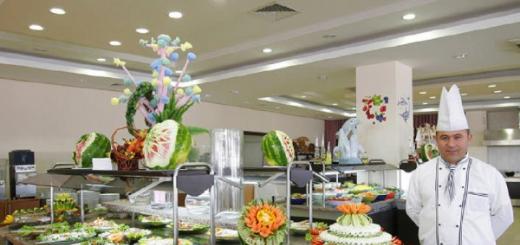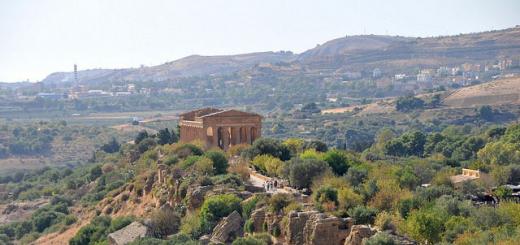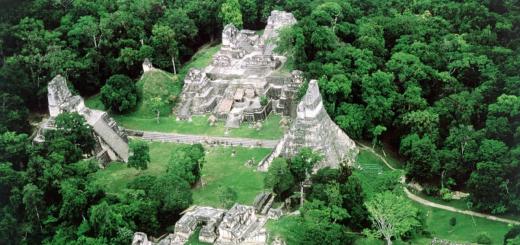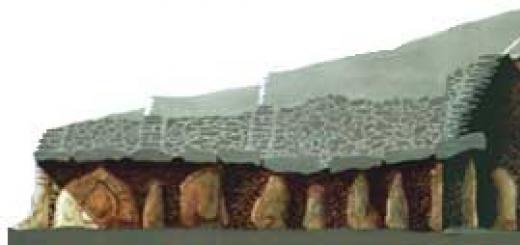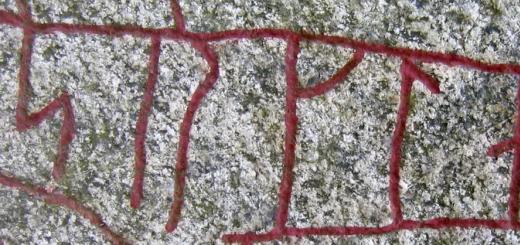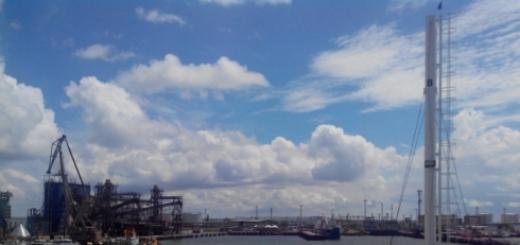How to get to Agrigento
Agrigento is considered a beautiful historic town located on the southwestern coast of Sicily. The bulk of tourists are attracted to Agrigento by the opportunity to see the so-called "Valley of the Temples", where many ancient objects and monuments have been preserved. Agrigento is considered a popular excursion destination from Palermo and Catania.
You can get to Agrigento from any Sicilian town, but most often, tourists come here from Palermo or Catania, two major cities on the island that have international arrival airports. Both Palermo and Catania can be reached from Russia by air. There are direct flights to Palermo, flights to Catania with transfers in Rome or Milan. Flight schedules can be found on search engines Aviasales , Buruki and others. You can also arrive in Sicily by ferry from mainland Italy.
Palermo – Agrigento
The distance between Palermo and Agrigento is about 130 km in a straight line. There are several ways to get from Palermo to Agrigento: public transport (buses, trains), or car rental. Between the cities there is a daily train service with a frequency of 1-2 times per hour throughout the day. Travel time from Palermo will be about 2 hours, and the fare is 10-11 euros one way. You can check the schedule and buy tickets online at the railway service
.
Around the same time, you can also get there by regular bus. Buses leave every 2 hours throughout the day. The first bus leaves at 8.15, the last - at 18.00. The fare is 9 euros one way. The departure station in Palermo is Pizzetta Cairoli, the arrival station in Agrigento is Piazzetta Rosselli.
In order to travel around Sicily at your own pace and rhythm, you can rent a car in Palermo. Rental offices can be found both in the city itself and at the airport of arrival. To register a car for rent, you will need a passport, an international driver's license, a bank card to pay for services. You can pre-book the desired class of car on special services , , and others. Palermo and Agrigento are connected by highways SS121 and SS189. Estimated travel time is 2 hours.
 Herbert Frank/View of the Valley of the Temples
Herbert Frank/View of the Valley of the Temples Catania - Agrigento
The distance between Catania and Agrigento is 160 km. You can also get from one locality to another by public transport or a rented car. However, there are only regional trains between Catania and Agrigento, so the travel time will be about 4 hours. Trains depart 1 time in the morning, several times in the afternoon and twice in the evening. The last train leaves at 17.32. The fare varies from 12 to 20 euros one way. You can check the schedule and buy tickets online at the railway service
.
As for buses, they run more often, almost every hour. Transportation is carried out by the bus company SAIS TRASPORTI. The fare is 13.4 euros one way and 22 euros round trip.
Much it will be faster to get there by car. Catania and Agrigento are connected by highways A19 and SS640. Travel time will be approximately 2 hours. You can rent a car both in Catania itself and at the airport of arrival. This option is quite popular among tourists traveling in Sicily. You can book the desired class of car in advance (before departure) at specialized services , , and others. Advance booking is especially important in the summer, when the influx of tourists to the island increases dramatically.
 Darold Massaro/Near Agrigento
Darold Massaro/Near Agrigento Agrigento Hotels
Agrigento is significantly removed from other tourist centers of Sicily, so tourists often stay in Agrigento longer than 1 day when they come for sightseeing. All conditions are created for this in Agrigento, and there is an opportunity to stay in places of accommodation for every taste. The most popular options are bed and breakfast hotels. Apartments, holiday homes, guest houses and, of course, standard hotels of various star ratings are also in demand. High ratings from tourists on Booking.com received the following accommodations in Agrigento:
Hotel Agrigento Home – the hotel is located in the city center and offers its guests rooms of various sizes, including family-type rooms. There is free parking, a bar and free Wi-Fi on site. Breakfasts are paid extra. The rooms are studio style and have a dedicated kitchen area;
La Passeggiata di Girgenti This bed and breakfast is conveniently located. You can stay in rooms of different sizes, each room has a coffee/tea maker. Breakfasts are included in the price. Wi-Fi is available free of charge throughout the hotel. Free public parking is available nearby;
Le Maioliche – the hotel is located near the city center, as well as the railway and bus stations. It offers a relaxing terrace, parking and roomy rooms. Breakfasts are included in the price. The front desk provides tour desk and luggage storage services. WiFi is provided free of charge;
La Terrazza di Carolina – the hotel is located near the center and can offer its guests a terrace for relaxation, family rooms, free Wi-Fi, parking. Some rooms have a balcony overlooking the historic centre. Breakfasts are included in the price. Wi-Fi is available in the hotel rooms for free;
B&B Sorahnia – Design House – the hotel has a picturesque location, from the windows of the rooms overlooking the garden and mountains. Guests can stay in rooms of various sizes, some rooms have a terrace. Breakfast is included in the price. Wi-Fi is available free of charge throughout the hotel. Free private parking is also available.
 Allie_Caulfield/Nature around Agrigento
Allie_Caulfield/Nature around Agrigento Attractions Agrigento
Agrigento itself has a compact historical center, in which interest, above all, is Cathedral cities and Church of Santa Maria dei Greci. Also a curious object is the local Archaeological Museum. But the main attraction, for which they go to Agrigento from all over the island, is the so-called Valley of the Temples located in the vicinity of the city.
The Valley of the Temples is an open-air archaeological museum. Here, in fairly good condition, ancient Greek temples of Juno-Lacinia and Concordia, as well as some other objects.
 Eduardo M./Valley of the Temples, Agrigento
Eduardo M./Valley of the Temples, Agrigento The park-museum is open to visitors every day, in summer the opening hours of the park are extended so that tourists can admire the sights at sunset. You can buy tickets online or at the box office, but please note that during the "high season" there are queues at the entrance to the park due to the popularity of this place.
If you want to combine sightseeing with swimming in the sea, then you should keep in mind that Agrigento itself is not on the coast, but a few kilometers from it. So, the nearest beach is located in the town San Leone, here the beach is sandy, and the shore is gently sloping. If you want to see more picturesque places, then go to the town Scala dei Turci where the rocky shores go straight into the sea.
 Herbert Frank/Valley of the Temples, Agrigento
Herbert Frank/Valley of the Temples, Agrigento Agrigento is the ancient capital of the province of Sicily of the same name, the residence of the bishop and one of the most amazing cities in all of Italy. Antique architectural monuments from the archaeological excavation area are included in the UNESCO World Heritage List. Most of the temples of Agrigento are unique in their preservation. The city itself is small, but very picturesque: on the one hand, it is surrounded by turquoise sea surface, and on the other, there are endless olive groves and gardens with almond and orange trees. In Agrigento, amazingly beautiful photos of natural landscapes are obtained.
- Area: 244 km²;
- Timezone: UTC+1, summer UTC+2;
- Population: 59,400.
general information
Despite its rich history, this beautiful corner of Sicily has preserved many medieval buildings, including palaces, cathedrals, and squares - this place has absorbed the heritage of several dozen cultures. Today, there is a well-developed network of railways connecting Agrigento with major cities - Palermo and Catania. Also, this area is famous for its beautiful sandy beaches - the best on the entire coast of Sicily. The swimming season lasts almost the entire year, but the dry and very sunny weather in Agrigento is complemented by African winds, and it is especially hot from May to October. Therefore, for a comfortable exploration of the main attractions, it is better to come in mid-autumn or spring. 
A selection of profitable air tickets through Aviadiscounter (search as Aviasales + a selection of promotions and sales of airlines).
| From where to where | departure date | Find a ticket |
|
Rome → Comiso | ||
|
Pisa → Comiso | ||
|
Frankfurt am Main → Comiso | ||
|
Brussels → Comiso | ||
|
Turin → Comiso | ||
|
Milan → Comiso | ||
|
Moscow → Comiso | ||
|
Bucharest → Comiso |
And for the selection of long-distance transport (airplanes, trains, buses) in Europe, try, the service offers the best ways to travel along popular routes.
Or plot your route.
Valley of the Temples
The small town is saturated with the atmosphere of antiquity and greets tourists with many colorful medieval buildings, but all the streets invariably lead to the main relic for travelers: the Valley of the Temples of Agrigento, which is a huge open-air archaeological museum. There are 7 ancient temples here:
- The Temple of Hercules is recognized by scientists as the oldest building in the entire valley. Its construction dates back to 510 century BC. e. Over its more than a thousand-year history, the temple has undergone minor restorations, but only 8 columns out of 36 and small parts of the altar have survived to this day - the rest was destroyed.
– The Temple of Zeus Olympeion, built presumably in 480 BC, was originally conceived as the most majestic and largest in the world known at that time: its area was 6340 square meters, the height of the columns reached 19 meters, at the entrance there were huge niches with figures 8 meters high Atlantes, composed of stone blocks. Archaeologists have discovered the surviving part of a similar sculpture, an exact copy of which is located at the foot of the temple, and the original is carefully kept by the Regional Archaeological Museum, located on the territory of the Valley. Unfortunately, this most beautiful building was subjected to maximum destruction even before the beginning of our era. 
- Temple of the Dioscuri - Pollux and Castor. These deities were especially revered in ancient Akragas, which stood on the site of modern Agrigento, since they were considered the patrons of warriors and sailors. The construction of the temple dates back to the middle of the 5th century BC. Its 4 surviving columns and entablature were cleared in the middle of the 19th century. This part of the temple has become one of the symbols of Agrigento.
– The Temple of Concordia or Concord dates back approximately to the 5th century BC. Its name comes from a Latin inscription found nearby about the conclusion of peace. It is assumed that this temple is also dedicated to the Dioscuri. This is the best preserved building that has survived to this day due to the fact that in the VI century AD it was rebuilt into the church of Peter and Paul. The temple is represented by 34 columns of almost 7 meters in height, located on a large rectangular platform. The unique majestic simplicity and proportionality of all proportions of such an ancient building amazes every tourist.
- The temple of Juno is also attributed to the 5th century BC. e. Burnt down in 406 BC and restored by the Romans, it was supposedly used for marriages. Only the northern colonnade of the temple has been well preserved. 
– The Temple of Asclepsius – the 5th century BC, is notable for its small size, it is located not far from the walls of the ancient city of Akragas that once stood in this area. It is believed that here was a place of pilgrimage for the suffering, seeking to cure their illnesses. The excavations began in 1926 and are still ongoing. Scientists discovered that there was a hospital or a hotel for 28 people near the temple, and a cistern with healing water was also found there.
- Temple of Vulcan - 5th century BC. Judging by the ruins, it was a monumental and perhaps the largest building in the Valley. However, only the ruins of a completely destroyed temple have survived to this day.
Agrigento is a charming ancient city, and it is not possible to tell about all its sights, moreover, it is better to see once than hear a hundred times. Come and touch the thousand-year history of the once mighty civilizations.
Services for tourists that will save or get more for the same money:
- Insurance: the journey begins with the choice of a profitable insurance company, allows you to choose the best option for your requirements;
- Flight: looking for the best tickets
Agrigento- a city of undeniable charm, archeological monuments of unforgettable beauty and memories of the peoples that imprinted its name through the ages.
Akragas for the Greeks, Agrigenta for the Romans, Kerkent Germent for the Arabs and Girgenti for the Normans: the name Agrigento was officially given to the city during the Nazi occupation, due to a mispronunciation of the Latin name "in Italian".
Agrigento located on a hilltop, in the very place chosen by the Arabs, who completely rebuilt the city after its conquest and total ruin. Historical evidence of the original Akragas and Greek domination remains only in the Valley of the Temples, located at the very base of this hill.
The panorama that Agrigento offers will certainly captivate everyone: the close proximity to the sea, the hilly landscape with an endless array of olive, orange and almond trees and flowers, cobbled alleys and small courtyards that form the city center. All this has a mysterious charm, which increases sharply in the hours before sunset.
Panorama of the Temple of Juno. Photo flickr.com
Agrigento is without a doubt a city that will not leave its visitor disappointed, because it is simply impossible to get bored here. Churches, palaces, museums, archeological monuments, fountains, squares and streets: in this city located in the southwest of Sicily, many sites of historical, artistic and archaeological heritage of various cultures and peoples have been preserved.
It should be noted that one of the leading writers of Italy, Luigi Pirandello, Nobel Prize winner in 1934, was born in the province of Agrigento.
A Brief History of Agrigento
Founded in 581 BC Greek settlers from Rhodes and Crete, Akragas quickly became one of the most important cities of Ancient Greece, the second most important Greek colony after.
The urban area of the Greek Akragas consisted of 456 hectares and was surrounded by fortress walls with nine gates. The population of the city was about 300,000 inhabitants, and Akragas itself was known among the Greek poets as "the most beautiful city of mortals." The city reached its peak in the fifth century BC, under the rule of the tyrant Theron, who expanded his holdings to the northern coast of Sicily. During this period art and culture flourished in Akragas, with the construction of a temple to Zeus and most of the temples that can still be seen in the Valley of the Temples today.

Remains of the Temple of Zeus in the Valley of the Temples of Agrigento. Photo flickr.com
In 210 BC the city was conquered by the Romans and annexed to, however, in the following centuries, Agrigento, still under the rule of Rome, survived the invasion of the Arabs. The conquerors destroyed the city almost completely, and then founded a settlement on the top of the hill, where today you can admire the historical center of the city in typical Arab form, with small lanes and courtyards that converge on Via Atenea, which continues to this day to be the most important "artery" of the city.
Via Atenea crosses the entire historical center of Agrigento and houses many beautiful palaces and churches, which sometimes differ completely in architectural style from each other. In the temples and churches of the city, treasures are stored, often unknown to the general public, for example, here you can see numerous works by Serpot and Gagini. In the heart of the old city, as many centuries ago, small private taverns are open, where wine is poured, anchovies and Sicilian olives are served.
In 1087, Agrigento was conquered by the Normans. The Normans gave a new impetus to the development of art and Christian culture, built numerous churches and fortifications that protected Agrigento from Saracen pirates.
In the 18th century, the city was under the rule of the Bourbons, until 1860, when Sicily was annexed to the Kingdom of Italy.
Today Agrigento has an area of 245 sq. km, the city is located at an altitude of 230 m from sea level and has about 55,500 inhabitants.
What to see in Agrigento?
Historical Center
The historic center of Agrigento is rich in historical monuments and palaces that tell of the glorious past of the city, but, unfortunately, today the old city is in a state of neglect. Nevertheless, this fact does not prevent tourists from walking along its streets and admiring many places of historical and artistic interest.

The central street of Agrigento is Via Atenea. Feast of San Calogero. Photo flickr.com
Churches
In Agrigento you will find many religious buildings that are worthy of your attention: from the church "Addolorata", famous for its underground crypts, to the church of San Francesco di Paola, with two beautiful bell towers; from the "representative" of the Baroque - the church of San Giuseppe to the Greek-Albanian church of the 16th century "Del Itria". In addition, interesting temples, from an architectural and historical point of view, are
the Baroque Church of San Lorenzo, with a façade adorned with numerous statues;
the Basilica of the Immaculate Conception with a beautiful interior containing marble tombs of nobles and clergy;
Church of St. Nicholas, where there is a wooden crucifix, which tells the story of Pirandello.
Do not forget to visit the Cathedral, now known as the Cathedral of St. Geraldo, the patron saint of the city. This building was built in 1100, and its construction lasted over 200 years!

Cathedral of Agrigento. Interior. Photo flickr.com
These are just some of the basilicas and churches that the city of Agrigento offers for inspection. In addition to photo sessions in front of each of the temples of the city, we recommend that you go inside and appreciate the heritage of great significance stored in each of them.
Palaces and other interesting architectural objects
In addition to religious monuments, Agrigento will offer many beautiful buildings and structures for tourists. These include the City Hall, which was built on the ruins of an ancient Dominican monastery of the 17th century, the Prefectural Palace, built in the second half of the 19th century, the building of the post office of the fascist era and the Palazzo del Genio Civile Palace. The list of interesting buildings should also include the Pirandello Theater (formerly dedicated to Queen Margherita and only after 1946 to the famous writer), as well as the Municipal Theater of the city, built by Giovanni Battista Basile and Dionisio Sciascia.

Piazza Pirandello. Agrigento. Photo flickr.com
Luigi Pirandello's parental home
Everyone who comes to Agrigento must go to the parental home of Luigi Pirandello, where the Nobel Prize winner was born in 1867.
Squares and avenues
Much of Agrigento's beauty comes from its avenues and squares. Start your walk in Viale della Vittoria, where Villa Bonfiglio is located, the most beautiful park in the city, with its green spaces, then stroll through Piazza Vittorio Emanuele, full of beautiful buildings, don't miss Piazza Cavour and Marconi and of course Via Atenea, which runs through the whole city.

Piazza Municipio. Agrigento. Photo flickr.com
Museums
The museums of Agrigento certainly deserve a visit. Among all regional museums, the Archaeological Museum of Agrigento stands out in importance, the most visited in all of Sicily: its collections allow you to travel through the history, art and ethnography of the region. Don't miss the Museo Civico, located in Piazza Municipio, which houses some medieval and renaissance sculptures and paintings of great artistic value.
Province of Agrigento
Beach lovers should definitely head to San Leone Beach, the most famous and famous beach in the entire province of Agrigento, located at the foot of the Valley of the Temples. In summer, this beach is always crowded with a crowd of vacationers. Another obligatory stop in the province of Agrigento is the town of Porto Empedocle, birthplace of Pirandello and the contemporary Italian writer Andrea Camilleri. In addition, the ruins of an ancient Roman villa have been preserved in this seaside town.

San Leone beach. Sunset. Photo flickr.com
Valley of the Temples
Although the city of Agrigento cannot be compared in beauty with, or Rome, it has something to offer the tourist. Travelers from all over the world travel to Agrigento to admire the hallmark of this Sicilian city: the picturesque Valley of the Temples, which is nothing more than the ruins of ancient Akragas, that is, the original Greek Agrigento. Located in the southeast of the center of Agrigento, this valley allows you to imagine the period of prosperity and greatness of the city under the rule of the Greek Empire. Here the ancient Greeks erected a number of Doric temples in the fifth century BC; some of them are still perfectly preserved, some of them are only the remains, but even the sight of the ruins leaves every tourist speechless.
Entrance is paid, the valley is open from 9:00 am until sunset.
The main attractions of the Valley of the Temples:
Temple of Concordia
This is one of the most impressive and best preserved temples. Built around 430 BC, the Temple of Concordia or Concord is a Doric-style ritual building that almost 100% resembles the famous Parthenon temple in Athens. The temple has a quadrangular shape, its width is 20 meters and its width is 42 meters. Its columns were built by ancient Greek architects in such a way as to introduce everyone into a state of optical illusion: the temple looks higher and more majestic than it actually is.

Temple of Concordia. Photo flickr.com
Temple of Zeus
Executed in rows of seven columns, unlike all other temples, which are based on six columns, the Temple of Zeus is one of the largest buildings in the Valley: its dimensions are 113 meters long and 36 wide. Unfortunately, the temple was not completed. The temple in honor of the god Zeus, the lord of Olympus, was built in honor of the victory of the Carthaginians, but today only a row of columns remains from this temple. Next to this temple is Atlas, which once supported the vaults of the temple (now in a supine position), 8 meters in height.

Atlant. Temple of Zeus. Photo flickr.com
Other temples
The rest of the temples are even worse, but it is worth noting the Temple of Hercules (Tempio di Ercole), probably the oldest in the Valley, the Temple of Juno (Tempio di Giunone), the Temple of Dioscuri (tempio dei Dioscuri), the tomb of Theron (la tomba di Theron), the Temple Castor and Pollux (Tempio di Castoro e Polluce).

Temple of Juno. Photo flickr.com
What to try in Agrigento?
As usual in cities close to the coast, Agrigento is dominated by seafood-based cuisine. Try pasta with sardines, squid soup, cod "alla saccenese", baked mussels with chili, grilled fish or marinated raw shrimp - these are dishes that you can find in every restaurant. Departing from the "sea" theme, in Agrigento you can enjoy a long series of traditional recipes. These include, for example, rabbit stew, sausages with fennel, sesame and chili, lean veal seasoned with cheese and ham, cooked in the oven, etc.
Don't forget to try the sweets, which are a real gem of this province of Italy. Caponata and Cassatine, cannoli and almond dough, chocolate and pistachios are just some of the city's main desserts. Almonds are a distinctive pastry addition in the region: among the most famous recipes are "Cubaita", with honey and roasted almonds, and "MARTURANA" cakes.
Holidays in Agrigento: main events
Almond Blossom Festival
The most popular event that the whole city gathers for is the Almond Blossom Festival. This holiday is celebrated in February to celebrate the imminent arrival of spring in Sicily. The almond blossoms make Agrigento a truly spectacular place this season: thousands of tourists flock to the city during this period as the Valley of the Temples turns into a musical scene overflowing with scents and soft pink colours. In combination with almond blossom, two international folklore festivals take place in the heart of the ancient Greek city with the Golden Temple Award for the best folk group.

Almond Blossom Festival. Photo flickr.com
Feast of San Calogero
A whirlwind of sounds, colors and processions - this is how the feast of San Calogero is celebrated in July for two weeks, despite the fact that this saint is not the patron of the city (the protector of Agrigento is San Geraldo). However, according to tradition, it is in honor of San Calogero that Agrigento organizes a huge mass procession with a statue of the saint through the streets of the city, singing folk songs and dancing to the sounds of "Zingarella".

Feast of San Calogero. Photo flickr.com
Feast of Persephone
Numerous exhibitions and performances take place in June in the Valley of the Temples, near the temple of Hera, to celebrate the ancient Greek festival of Persephone, daughter of Zeus, goddess of fertility.
Blues&Wine Soul Festival
Once again, the Valley of the Temples becomes the undisputed star of the holiday, which takes place in July. The blues and soul music festival, along with wine tasting, takes place among the remains of ancient Akragas - what could be more impressive! A similar event is held in August as part of a festival called Moments of International Folklore.
Where to stay in Agrigento?
Agrigento offers a good selection of hotels, especially three and four star hotels. Depending on your needs and your budget, you can choose from different categories of hotels - hotels, agritourism cottages or bed-and-breakfasts.
We invite you to familiarize yourself with the Top 5 best hotels in the province of Agrigento, according to the reviews of travelers left on the Boking.com portal.
1. Foresteria Baglio Della Luna - Via Serafino Amabile Guastella 1C - C.da Maddalusa (Valle dei Templi), 92100 San Leone, Italy
Hotel Baglio della Luna is 5 km from the Valley of the Temples in Agrigento, 800 meters from the beach.
2. Colleverde Park Hotel - Via Dei Templi, 92100 Agrigento, Italy
Hotel Colleverde Park is a 15-minute walk from the famous archaeological site of Agrigento and 2 km from the centre. The windows overlook the Valley of the Temples.
3. Hotel Exclusive - Via Acrone15, 92100 Agrigento, Italy
Hotel Exclusive is located in the center of Agrigento, opposite the train station. The hotel overlooks the Valley of the Temples and the Mediterranean Sea.
4. Hotel Costazzurra - Via delle Viole 2, 92100 San Leone, Italy
Hotel Costazzurra is located in the seaside resort town of San Leone, just 3 km from the Valley of the Temples.
5. Hotel Concordia - Via San Francesco D "Assisi 11, 92100 Agrigento, Italy
Hotel Concordia is located in Agrigento, a 5-minute walk from the train station.
How to get to Agrigento?
By plane
Unfortunately, the city of Agrigento does not have its own airport. You can land in the city of , or , and then take a bus, or perhaps rent a car (via this link). Your efforts will be rewarded when you arrive at your destination!
Palermo Falcone Borsellino Airport(PMO) serves direct flights from all major Italian and European cities. After landing in Palermo, you can reach Agrigento by first taking the "Trinacria Express" train, which departs every half an hour from the airport and goes to Palermo Central Station. There are many trains from Palermo Station to Agrigento (travel time is about 2 hours).
There is also a direct bus to Agrigento from Palermo Airport (SAL).
The alternative is Catania-Fontanarossa International Airport (CTA), where planes of all major international companies land.
From Catania airport there is a direct bus to Agrigento (SAIS Trasporti). Travel time is about 2.5 hours.
By car
From take the A18 until Catania, then continue on the A19 towards Palermo, exit at " ", and finally continue on the SS 640 until Agrigento.
From Palermo, take the A19 towards Catania, exit at Villabate, then continue on the SS 121 for about 118 km until you reach your destination.
From the SS 115 take Noto, Ragusa and Gela to Agrigento.
From mainland Italy:
follow the A3 Salerno-Reggio Calabria, exit at Villa San Giovanni, where the ferry to Messina is located. From Messina, follow the A18 to Catania, continue on the A19 Catania-Palermo, exit at "Caltanissetta", then continue on the SS 640 to Agrigento.
By train
Agrigento has its own train station, but with the exception of Palermo, train connections to other cities in Sicily and Italy suffer. If you take the train in Taormina or Catania, you will have to make one or more transfers.
By bus
The best way to get to Agrigento is by buses that depart/arrive at the city's bus station (Piazza Rosselli).
Agrigento (Agrigento) - a small medieval town, which in itself deserves attention, but completely fades next to the neighboring Valley of the Temples (Valle dei Templi), the most important ancient Greek ruins in Sicily. Modern Agrigento is one of the liveliest cities in Sicily, which, moreover, enjoys a special, very peculiar status: it is here, as you know, that many notorious mafia families of Italy found shelter.
During the day, the ruins are usually teeming with tourists, so it is worth arriving there early in the morning or before closing time - in order to avoid crowds.
Walks in Agrigento
How to get there
Agrigento is easily accessible by both bus and train. For example, several trains a day run from Palermo (8-13 EUR, 2 hours on the road, 11 trains per day) and Catania (15-23 EUR, about 6 hours, 6 per day). To other directions, although trains run there, it is better to get there by bus.
There is a left-luggage office at the station, 3 EUR per 12 hours.
Buses are considered the number one transport in Sicily, and Agrigento is no exception: many locals and tourists prefer to get to the city on them. The bus station is located in Piazza Rosselli, just behind Piazza Vittorio Emanuele I, where the ticket office is located and you can find the timetable. Autoservizi Cuffaro runs buses to Palermo daily (11 EUR, 2 hours on the road, 7 trips from Mon to Sat, two on Sunday). Lumia organizes buses to Trapani (from 48 EUR, 5 hours, three times a day from Mon to Sat, one on Sunday), and SAIS sends buses to Catania (17-24 EUR, 5 hours on the way, departure every half an hour). Prices on the page are for April 2019.
Maps of Agrigento
By car
The SS189 connects Agrigento with Palermo, while the SS115 goes all the way to the coast, northwest of Trapani and southeast of Syracuse. To get to Enna, look for the SS640 through Caltanissetta.
It is impossible to drive a car into the medieval city center, since almost all of it is pedestrian. Parking is available near the station (in Piazza Marconi) and in Piazza Rosselli.
Hotels
There are not so many hotels in Agrigento, but finding an option to your liking is not difficult: there are “five” and pretty “three”, and in the vicinity you can even find farms that accept agritourists under their roof.
Transport
You can get to the Valley of the Temples by city buses that stop opposite the railway. station. Look for buses number 1, 2 or 3, get off at the stops "Museum" or "Piazzale dei Templi". Bus number 1 goes further to Porto Empedocle (2.80 EUR). Bus number 2 - to San Leone (1.20 EUR). Buses Linea Verde ("Green Line") leave every hour from the railway. station to the cathedral.
Tickets can be bought at the bar opposite the bus stop and punched on board.
3 things to do in Agrigento
- Once in Agrigento in February, it is mandatory to go to the Valley of the Temples, even if you are not a big fan of antiquity. It is during this month that hundreds of almond trees, collected from all over Italy, bloom there. Not a single impressionist dreamed of such a collection of white and pink shades.
- For the rest of the year, anyway, go to the Valley of the Temples, if only to look into the Spizzulio wine cellar (Via Panoramica Valle dei Templi, 23). And taste amazing pasta with sun-dried tomatoes with a glass or two of wine.
- Having fallen in love with the local cuisine (everyone does it here for sure), go 30 km from Agrigento to the Mandranova estate. There you can buy a bottle of olive oil to take with you, and then, under the supervision of the hostess Silvia, take a three-hour cooking course. If you wish, you can also stay here for the night, be sure to swim in the pool (it is filled with water from mineral springs).
Attractions and attractions in Agrigento
Here are the unique temples of Juno-Lakinia and Concordia with adjacent early Christian catacombs, the ruins of the temples of Zeus, Hephaestus and Hercules, the sanctuary of Asclepius, the pre-Hellenic cave temple near the sanctuary of Demeter and the church of San Nicola.
Most of Agrigento itself is quite modern, but the city still boasts a fair amount of medieval buildings, especially the cathedral and the church of Santa Maria dei Greci. There is also an excellent Archaeological Museum with an exhibition of objects found in the excavations of the ancient city.
Architectural monuments of Agrigento from the archaeological site ( "Valley of the Temples"") are listed. Many temples of Agrigento are unparalleled in terms of preservation. Numerous antique buildings are combined with baroque architecture.
Ancient Akragas was founded as a colony of people from the island of Rhodes from, around 581 BC. Over time, thanks to active trade, the city of Akragas, becoming one of the largest cities of the Ancient World with a population of at least 20 thousand people. Akragas was an independent city, but in 406 BC. besieged by the Carthaginians. The siege lasted 8 months and ended with the defeat of Akragas. The Carthaginians captured and destroyed the city. It was later restored, but was no longer able to regain its former brilliance. In 262 BC. Akragas was annexed to Rome as an ally, retaining its constitution.
Weather in Agrigento:
Attractions Agrigento
Among the main attractions of Agrigento are - Valley of the Temples(listed) and Old town of Agrigento.
Valley of the Temples - Agrigento, Sicily - Temple of Concord
Impressions from Agrigento
If we talk about personal impressions of Agrigento, then the city itself looks very slum and poor - strange, sometimes scary, houses, very worn out, at least from the outside. Simple restaurants, poor people, in general, one of the most "worn" cities in our journey through Sicily.
On the other side. The Valley of the Temples in Agrigento is certainly impressive. To some extent, even more than the Acropolis in Athens - as you can come close to the monuments ... In general, it is very worth stopping by here, touching the history ... But you should not expect much from the city itself. And the car here, by the way, will not be very superfluous - the Valley of the Temples is located a few kilometers from the city center, you can walk, but it's tiring car!)
Valley of the Temples in Agrigento
The territory of ancient Akragas occupies a huge area, most of which has not yet been excavated. The Valley of the Temples proper is an archaeological zone south of the ancient city, where several monumental ancient Greek temples in the Doric style, built between the 5th and 6th centuries BC, have been preserved. In the evenings, the temples are illuminated, creating a unique atmosphere. Some of the temples from the valley are surprisingly well preserved, which has no analogues outside of Greece. The very name "Valley of the Temples" is not entirely correct: there is no valley here, and the complex of temples is located on a steep hill.
- Opening hours: daily, including Sun and holidays, from 8:30 to 19:00.
- Entrance:
- East side with the temple of Zeus and the Greco-Roman quarter, except for the cave Fragapane and Antiquarium Paleocristiano) - 10 € , reduced 5 €
- The whole park-museum: 10 € , reduced 5 €
- Antiquarium Paleocristiano: €3, reduced €1.5
- Cave Fragapane: €3, reduced €1.5
- Night visit (from July 1 to September 5, Fri 19:30 - 21:30, on weekends and holidays 19:30 - 23:30) - 10 €
- In summer, the park can be very hot and there is almost no shade: bring water and a hat.

History of the Valley of the Temples in Agrigento
The first to discover this historical monument, and also began to clear and carry out the first excavations of the temple complex, was the Italian archaeologist Domenico Antonio Lofaso Pietrasanta (1783 - 1863). This happened at the beginning of the 19th century. In 1809, he inherited the title of Duke of Serradifalco, and it turned out that the temple complex was on the territory of his possessions. True, after three years he had to part with his own rights in connection with the abolition of feudalism on. However, this time was enough for the archaeologist enthusiast to present his findings to the public.

The philosopher Empedocles (5th century BC), originally from ancient Akragas, said:
"The power and splendor of this city are such that its inhabitants build temples as if they were destined to live forever, and eat and drink as if they were destined to die the next day."
The poet Pindar called Akragas "the most beautiful city among mortals." However, in 406 BC the city was besieged and destroyed by the Carthaginians. Traces of their invasion are still visible in the temple of Juno.
During the era of the Roman Empire, the "Tomb of Theron" was built on this territory, which is believed to have been the necropolis of those who died during the Second Punic War (218 - 202 BC). After Byzantium recaptured the territory of Sicily from the tribes of the Goths, some of the temples were turned into Christian churches, such as the Temple of Concord. Catacombs and tombs have been preserved from the Byzantines.
Architecture in the Valley of the Temples of Agrigento:
In the Valley of the Temples in Agrigento, there are 7 ancient temples, all in the Doric style:
- Temple of Juno, built in the 5th century BC and burned in 406 BC. the Carthaginians. In this temple, as a rule, weddings were celebrated.
- Temple of Concord (Concordia), whose name comes from the Latin inscription about the conclusion of peace, found nearby. The temple was built in the 5th century BC. Converted into a Christian church in the 6th century AD, it is one of the best preserved in the valley.
- Temple of Hercules, who was one of the most revered deities in the ancient city of Akragas. This is the oldest temple in the valley: destroyed by an earthquake, today it consists of eight columns.
- Temple of Olympian Zeus, built in 480 BC in honor of the victory of the city-state over Carthage. Differs from others in huge atlantes.
- Temple of Castor and Pollux. Despite the fact that only four columns remained from it, the temple has become a symbol of modern Agrigento.
- Temple of Vulcan, also built in the 5th century BC. It is believed to have been one of the most imposing structures in the valley; now, however, it is one of the most ruined.
- Temple of Asclepius located near the walls of the ancient city; pilgrims came here seeking to be cured of the disease.
The most well-preserved are two similar temples dedicated to the goddess Juno and the Temple of Concord. The last of the two temples was in a uniquely good condition due to the fact that it was turned into a Christian church in 597. And the area around it was used by Christians as catacombs.
Temple of Concord
Temple of Concord (Tempio della Concordia)- was divided into three halls: the central one, the portico in front of it and the opisthodom following it (a closed room in the western part of the temple). Stairs leading to the roof were made on the sides of the entrance to the central hall. The temple was decorated with white stucco and colored details. The twelve arches carved into the walls of the hall, as well as the graves dug into the floor, date back to the Middle Ages, when the zam was converted into a kind of Christian basilica with three naves. Despite the fact that the original appearance of the ancient Greek temple was thus distorted, the temple owes its exceptional safety to this restructuring. In 1788, during the restoration process, all elements of Christian decoration were removed, and the temple regained the appearance of a classical antique structure.
Other temples survive in a much more fragmentary state, having been destroyed by earthquakes and used as quarries.
Temple of Olympian Zeus
Completely destroyed huge Temple of Olympian Zeus. Its construction began on the order of the tipan Heron in honor of his victory over the Phoenician troops at the Battle of Himera (480 BC). The temple, which had already begun to be used, was never completed due to the invasion of the Carthaginians. It is the largest Doric temple (56 m wide and 111 m long) known in the world. Stones from the ruined temple were used to build a pier in the city of Porto Empedocle.
Temples dedicated to Hephaestus, Hercules and Asclepius were also built on the sacred territory, which also includes the sanctuaries of Demeter and Persephone. On the stones of the sanctuary, you can still see traces of fire from arson by the Carthaginians in 406 BC.
Theron's grave (Tomba di Terone)
Location of monuments in the Valley of the Temples:

Old town of Agrigento
![]()
Museo Civico
Walking west along Via Empédocle you will come to Piazza Pirandello. Here is the city hall of Agrigento and the City Museum - Museo Civico. The museum contains paintings of the 14th - 18th centuries, sculptures from the Middle Ages to the Renaissance. You can also see the memorial room of Luigi Pirandello.
Address: Cortile St Spirito, I-92100 Agrigento
Santa Maria dei Greci
Climbing up from the Museo Civico, through the narrow streets you can reach the church of Santa Maria dei Greci. It is a three-aisled building dating from the Norman period, built on the site of a Doric temple of Athena dating from 488 BC. You can go down the stairs to the space under the church, where the terraces and columns of the original temple have been preserved.
Cathedral of Agrigento (Duomo; Cattedrale di San Gerlando)
Agrigento Cathedral was built in the 11th century by the Normans on the highest point of the ancient Acropolis, as a replacement for the Temple of Zeus Atabyrios. The name comes from the word Atabyros, the highest mountain on the island of Rhodes, reflecting the Rhodian origins of the early settlers of ancient Akragas.
Unfortunately, already in 1244, as a result of a landslide, the temple was seriously damaged, which required its reconstruction. In the 13th and 14th centuries, the cathedral was enlarged, and in the 17th century it was remodeled in the Baroque style. On the south side, you can see double Norman windows. Next to the massive bell tower (1470), several steps lead to the main gate of the church.
Interior of the Cathedral in Agrigento
The interior of the church is a three-nave basilica, which was restored after the devastating earthquake of 1966. In the process of restoration, they tried to restore the medieval appearance of the nave. Only the splendid 15th-century wooden ceiling survives from later periods, although the choir stalls still retain a clear baroque decoration. The Gothic appearance has been preserved in the front part of the church - columns with octagonal bases and characteristic lancet arches. The elements of the facade and the bell tower belong to the Renaissance. On its south façade with lancet windows, there are signs of Spanish plateresque influences.
In the Gothic chapel to the right of the apse, there is a silver coffin containing the remains of the canonized Bishop Gerlando (1639). In the church, along the left nave, there are crypts of archbishops and noble citizens who lived in the 15th-17th centuries. Near the southern entrance is a glass urn containing the embalmed body of the holy martyr Felix, who died in the 3rd century.
To the west of the cathedral is the Episcopal Seminary, a 14th-century palace rebuilt in the 17th and 18th centuries.
Diocesan Museum
The museum displays church treasures, including frescoes from the 15th and 15th centuries and sacred relics from the Byzantine era.
The address: Piazza Don Minzoni, I-92100 Agrigento, Italy
Going down from the Diocesan Museum in the direction of the station, you will come to the square Piazza Purgatorio, named after the Church of Purgatorio located here (Church of Purgatory, as it is dedicated to the souls in Purgatory) or St. Lawrence. The church is located on the site of an ancient crypt.
The interior of the temple is richly decorated with stucco, including eight plaster statues by Giacomo Serpotta (17th century) depicting allegories of the virtues: Love, Simplicity, Mercy, Prudence, Justice, Religion, Courage and Meekness. On the vault are plaster images of the souls of purgatory. There is a decorative dome on the ceiling, decorated with a large fresco in the form of an ascending whirlwind. One of the chapels of the church - the crucifixion chapel - was decorated in the 18th century; it is decorated with gold and wooden crucifixes of the 17th century. In the temple, two confessionals of the 17th century have been preserved - the oldest in Agrigento.
Church of the Holy Spirit
Walking down the street Via Fodera you will come to the former Cistercian monastery of the Holy Spirit (Santo Spirito). The façade of the church (dating from about 1260) retains the original Gothic lancet gate and rose window, whose apex rests on a baroque pediment. For its grandiose architectural arrays dominating the eastern part of the city, it was called Bataranni, which means "big abbey" in the local dialect.
The walls of the church are decorated on the sides with plaster reliefs by the famous master Giacomo Serpotta (1695), which depict scenes from the childhood of Jesus. In a niche made in the left wall of the nave, a marble statue of the Virgin and Child (15th century) is placed. Pay attention to the bowl with holy water - it dates from the 5th century.
To the right of the church, the cloister, the chapter house and the refectory, which now houses the municipal library, have been preserved.
Church of San Biagio
If you go from Piazza Marconi (opposite Agrigento train station) along Viale della Vittoria to the southeast, you will reach the eastern edge of the Rupe Atenea cliff (351 m above sea level, with beautiful panoramic views) and the church of Chiesa di San Biadgio. This is a small church built in the 12th century during the Norman period from stones left over from ancient buildings. The church is located on the site of the Temple of Demeter, which was built around 480 - 460 BC. The foundation and part of the northern wall can be seen behind the church apse. It is also worth paying attention to two round altars in the north of the building, which supposedly served as sacred graves. Ritual accessories were preserved inside them, which made it possible to identify the sanctuary:
Sanctuary of Demeter and Persephone
You can go down the stairs to the stone sanctuary of Demeter and Persephone (Santuario Rupestre di Demetra), hollowed out in a steep mountainside Rupe Atenea. This is the oldest place of worship in Agrigento, dating back to the 7th century BC, even before the Greek period. The sanctuary is a narrow room in the rock, behind which there are two caves. Springs flow in the caves, the water from which fills several reservoirs in the courtyard. The discovery of ritual sacrificial accessories made it possible to confidently attribute the sanctuary to the cult of the goddess Demeter and her daughter.
Almond Blossom Festival
The Almond Blossom Festival is held annually in the first half of February. These are folk festivals, with songs, dances, costumes and fireworks.
Map of the city of Agrigento
Around Agrigento

Realmonte - Eraclea Minoa - Sciacca - Caltabellotta - Sambuca

The route goes along the western coast of Sicily, along the main road 115 Agrigento-Trapani. The high road offers excellent views of the beaches and cliffs. Snow-white cliffs in the area are especially popular with tourists. Realmonte and Eraclea Minoa.
Eraclea Minoa
For lovers of history, the most interesting point will be the town Eraclea Minoa, founded at the beginning of the 6th century BC. The ancient residential area is located on a small plateau rising from the sea. Among the ancient ruins, you can see the remains of a theater, a residential building and part of an ancient road. A small museum next to the archaeological site contains the most important finds from the Greco-Roman period. Nearby is a large beach with fine sand and lush cedar forest. Continuing along road 115 you will reach Sciacca.
Sciacca
Sciacca remarkable for its monuments of the Middle Ages and the Baroque era, among which the cathedral of the 17th century stands out in particular. Also worth seeing is the church of St. Margaret (14th century), the remains of the count's castle (14th century). The city has an ancient spa resort, famous for its serene waters. At the top of Monte Kronio is the sanctuary of St. Calogero (santuario di S. Calogero).
From here, the road goes deep into Sicily, in the direction of Caltabellotta and Sambuca di Sicilia.
Caltabellotta
Caltabellotta located almost on top of the mountain at an altitude of almost 700 meters. A number of artistic and monumental historical monuments are worth seeing here: the remains of a Norman castle, burial places (tombe sicane), the Chiesa Madre church (built by Count Ruggiero). From here one of the best views of Sicily opens.
Sambuca di Sicilia
Sambuca di Sicilia was founded by the Arabs. The ruins of the castle of Emir Zabut have been preserved here. The city has preserved an interesting complex of alleys of the Saracens. On the nearby mountain of monte Adranone (about 900 m above sea level), the ruins of a fortress from the 4th century BC have been preserved. Some of the most beautiful beaches in the area are Porto Palo and Lido Fiore.
On the territory of Realmonte preserved ancient roman villa, dating from the 1st century BC.
Acque Calde- a popular resort with thermal springs.
Pelagie Islands - Lampedusa and Linosa

This route leads from Agrigento to the Pelagie Islands of Lampedusa, Linosa and Lampione, located in the African Sea southwest of Sicily. On the islands you can admire picturesque views of nature, rocky islands, idyllic beaches contrasting with the azure sea. You can get to the islands from April to November. The Pelagic Islands are connected to the port Empedocle by Siremar ferries (journey time - 7 hours), and in July and August there are additional boats (3.5 hours).
- Lampedusa- the largest of the Pelagie Islands, it even has its own airport, where regular flights are made from the airport Punta Raisi (Palermo). There are many hotels on the island, it is especially suitable for diving enthusiasts.
- linosa- a small island of volcanic origin, with rich marine life, where many diving enthusiasts come throughout the year.
- Lampione- a small uninhabited rock with picturesque nature.
Raffadali - S. Angelo Muxaro

This itinerary will take you from Agrigento deep into Sicily to two historical centers that are different from the rest of the island.
Raffadali, from Arabic Rahl Faddal, which means "Beautiful House". Raffadali was founded by the Arabs, but on a site inhabited since the prehistoric period. This town is located a few kilometers north of Agrigento, at the foot of Monte Guastella, where prehistoric burials in caves and the ruins of an ancient castle of the 11th century have been preserved. Here you can see ancient Roman sarcophagi (3rd century). In the church of Chiesa Madre, an elegant bas-relief depicting the abduction of Proserfina has been preserved. The church library contains some archaeological finds from different eras.



